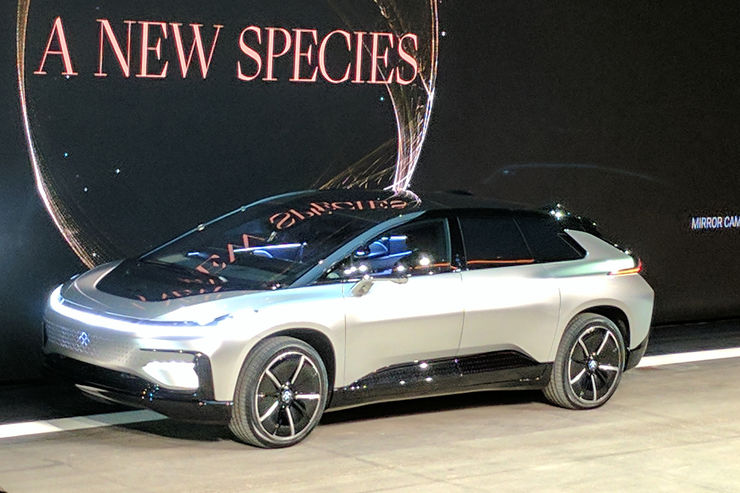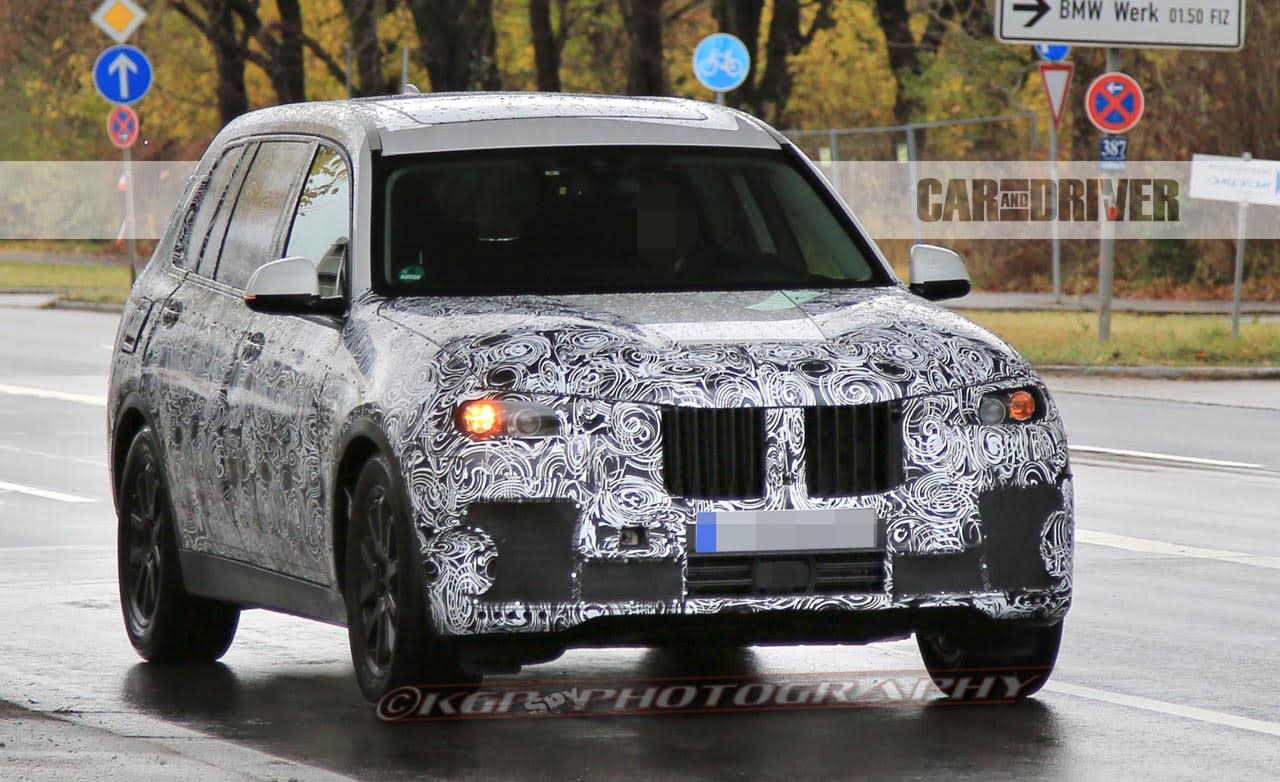600 Kilometer Reichweite, schneller als ein Ferrari
FF 91 Elektro-SUV

Das chinesisch finanzierte amerikanische Elektroauto-Startup Faraday Future hat auf der CES in Las Vegas mit einer glamourösen Premierenfeier sein erstes Serienmodell präsentiert. Der FF 91 ist ein SUV, der auf der variablen Plattform (VPA) aufbaut, die später auch andere Modelle tragen soll. Reserviert werden kann der Faraday FF91 ab sofort. Aber nur von Kunden in den USA, Kanada und China. Als Anzahlung werden 5.000 Dollar gefordert, die ersten 300 Besteller kommen in den Genuss ab März optional auf das Lauch-Sondermodell Alliance Edition upzugraden. Ein Teil des Mehrpreises wird dabei für einen Umweltfond gespendet.
Die VPA-Plattform integriert nebem dem Fahrwerk den kompletten Antriebsstrang samt Batterie und Inverter. Im FF 91 umfasst der Allradantrieb zusammen 783 kW (umgerechnet 1.065 PS) und 1.800 Nm starke Elektromotoren und eine 130 kWh große Batterie. Mit diesen Komponenten soll der FF 91 in 2,39 Sekunden auf Tempo 100 beschleunigen, die Reichweite wird mit 378 Meilen nach EPA-Standard (über 600 km) oder über 700 km nach NEFZ angegeben. Beim Thema Beschleunigung lässt der Faraday damit nicht nur die allermeisten Supersportwagen hinter sich, sondern auch die bislang in dieser Disziplin dominanten Tesla-Modelle S und X. An einem entsprechenden Schnellladesystem soll der FF 91 in nur einer Stunde vollgetankt sein, an der Haushaltssteckdose (240 Volt) soll die Ladedauer für 50 % der Kapazität 4,5 Stunden betragen.

Faraday Future FF 91Foto: Faraday Future
Eher rundlich gezeichnet: Der neue Elektro-SUV von Faraday Future.
Faraday Future FF 91
E-SUV mit mehr als 1.000 PS 50 Sek.
Rundgelutscher SUV
Die 5,25 Meter lange, 2,28 Meter breite und 1,60 Meter hohe Karosserie zeigt sich aerodynamisch rundgelutscht. Um den Luftwiderstand weiter zu optimieren, kommt der FF 91 mit aktiven Felgen, die sich bei höheren Geschwindigkeiten verschließen. Der Radstand liegt bei beachtlichen 3,20 Meter. Die schmalen Frontscheinwerfer reichen beinahe durchgehend von der rechten zur linken Seite des Fahrzeugs. Der Grill zitiert das Firmenlogo und scheint beleuchtet zu sein. Die Heckleuchten sind ebenfalls als ein schmales durchgehendes Leuchtband ausgeführt. Die 22-Zoll großen Felgen mit 275/40er Reifen sollen über aktive Aero-Elemente verfügen.
Die Außenspiegel wurden durch eine Außenspiegel-Kamera-Kombination ersetzt – die Spiegel lassen sich entfernen, wenn in dem jeweiligen Einsatzland Außenspiegel-Kameras legalisiert sind. Die gegenläufig angeschlagenen Türen ohne Griffe öffnen sensorgesteuert und stoppen automatisch vor Hindernissen. Die LED-Rundumbeleuchtung kommuniziert auf Wunsch mit der Umgebung und in der B-Säule kann der FF 91 auf Wunsch eine Begrüßungssequenz für den Fahrer einblenden. Natürlich lassen sich im Bordsystem auch persönliche Profile ablegen, die allerlei Einstellungen vorkonfigurieren.
Die Ledersitze im Interieur sind rechts und links von einer sich nach hinten verbreiternden Mittelkonsole angeordnet, sie sollen vielfach verstellbar sein, enrom viel Fußraum bieten sowie mit Heiz-, Massage- und Belüftungsfunktion ausgestattet sein. Glasdach und Seitenscheiben lassen sich verdunkeln.

Autonom Fahren kann der FF 91 ebenfalls. Hierzu ist neben 10 Kameras, 13 Radar- und 12 Ultraschall-Sensoren auch das erste Lidar-Lasersensorsystem in einem Serienfahrzeug verbaut.. Auf Wunsch parkt der FF 91 auch komplett selbständig ein. Eine Fähigkeit, die bei der Weltpremiere auch live zu sehen war. Ebenfalls an Bord: ein umfassender, schneller Internetzugriff.
In Produktion geht der FF 91 erst Anfang 2018. Preise wurden noch nicht genannt.
Faraday Future FF 91Foto: Faraday Future
Der FF-SUV wird mit einer Außenspiegel-Kamera-Kombination ausgeliefert.
Die ersten Erwartungen der Fans auf ein bezahlbares Mittelklasse-E-Autos hatte Faraday Future im Januar 2016 noch enttäuscht: Auf der CES in Las Vegas stand mit der Studie FFZERO1 ein einsitziger nicht straßenzugelassener Hardcore-Rennwagen, der angeblich mit rein elektrischen 750 Kilowatt (1.020 PS) bis zu 320 km/h schnell sein sollte.
Führungskräfte verlassen Faraday
Bis zu Präsentation des FF 91 machte die Firma eher Nagativ-Schlagzeilen. So gab es Gerüchte um unbezahlte Rechnungen in Millionenhöhe. Dazu könnte passen, dass laut des US-amerikanischen Technologie-Portals „The Verge“ zwei Top-Führungskräfte die Firma kurz vor der Weltpremiere verlassen haben. Markenchef Marco Mattiacci und Marketingchef Jörg Sommer sollen nicht mehr an Bord sein.
Mattiacci kam vor sieben Monaten zu FF und war vorher unter anderem Chef von Ferrari Nordamerika, Chef von Ferrari Asia Pacific und Teamchef des Ferrari-Formel-1-Teams. Der Italiener galt als jemand, der die finanziellen Probleme von FF in den Griff bekommen könnte.
Jörg Sommer kam erst vor drei Monaten von VW zu Faraday Future. Vorher war er in Führungspositionen bei Daimler, Opel, und Renault beschäftigt.
Faraday Future FF 91Foto: Faraday Future
Sobald das Fahren mit Kameras als Ersatz für Außenspiegel in dem jeweiligen Land legalisiert ist, können die Außenspiegel demontiert werden.



